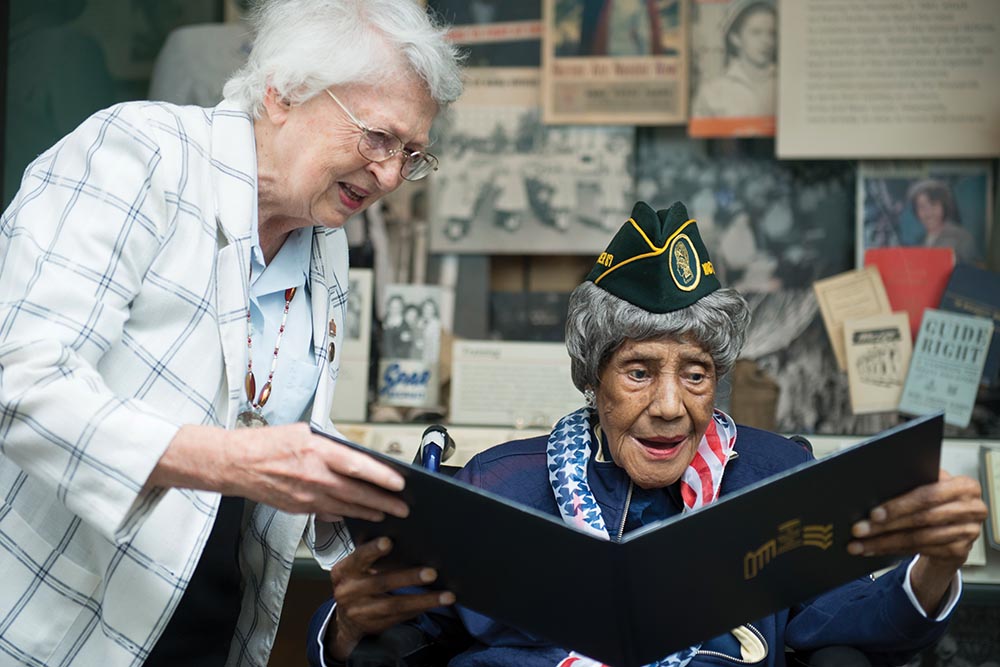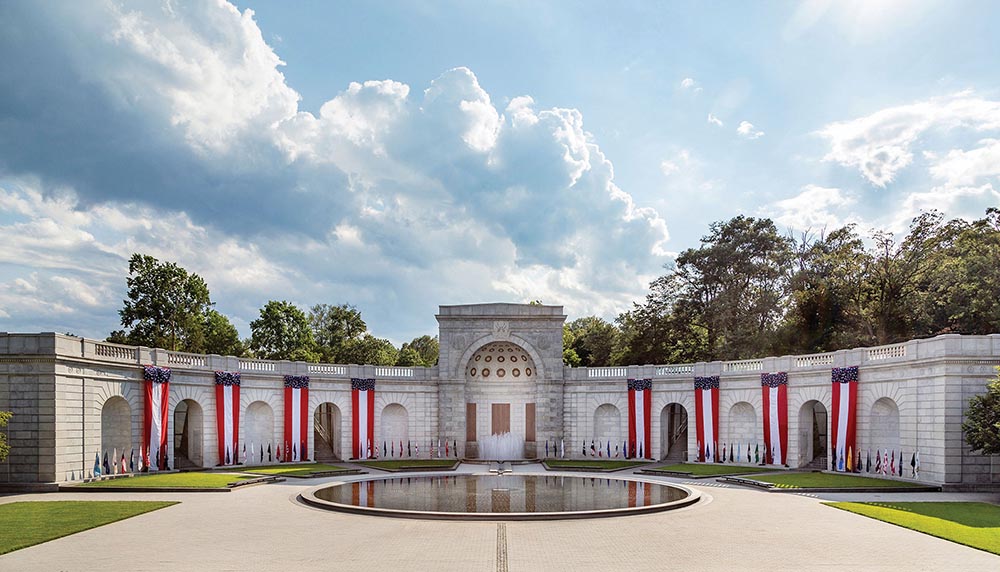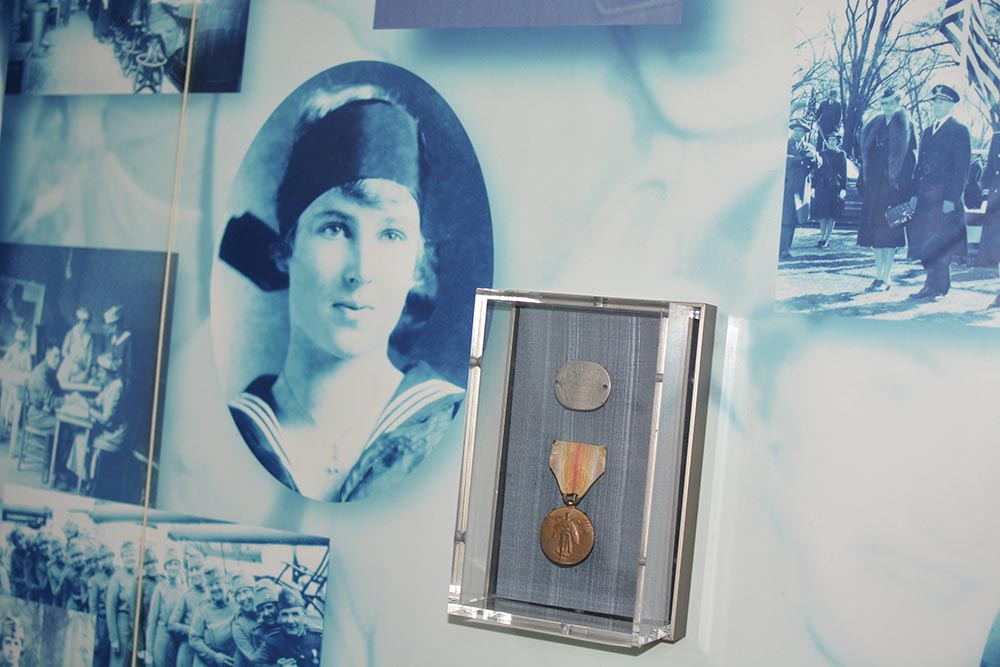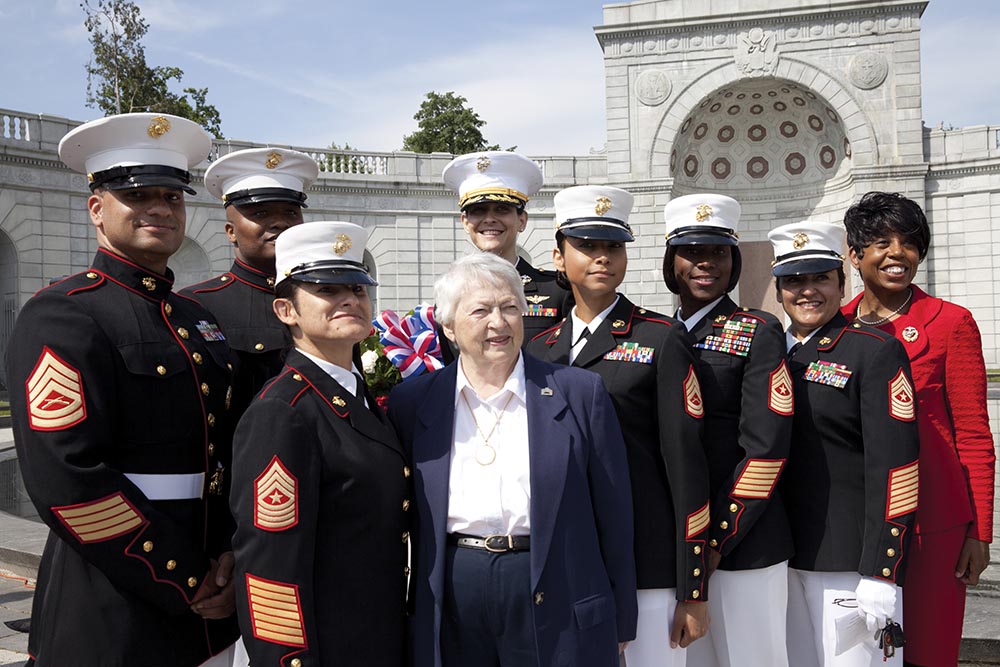
Her Story: Military Women’s Memorial Invites Servicewomen to Take Their “Rightful and Visible” Place
Warning: Undefined variable $feature_magazine in /bitnami/wordpress/wp-content/themes/mca/single-leatherneck.php on line 22
Warning: Attempt to read property "ID" on null in /bitnami/wordpress/wp-content/themes/mca/single-leatherneck.php on line 22
By: Sara W. Bock
Posted on June 10, 2024
Editor’s note: This article was re-published in honor of Women Veterans Appreciation Day on June 12. It was originally published in the August 2022 issue of Leatherneck Magazine.
After a recent visit to the Military Women’s Memorial and its education center, located at the ceremonial entrance to Arlington National Cemetery, a group of young women in uniform seemed to stand up a little taller and straighter than when they walked in mere hours earlier. At least that’s how the memorial foundation’s president, retired Chief Warrant Officer 5 Phyllis Wilson, USA, describes the visible boost in morale she observed as the noncommissioned officers absorbed the stories of the trailblazing women who came before them and paved the way.
“Many of them had no idea on whose shoulders they stand and what these women endured to make it easier for the next generation,” said Wilson, who assumed her current position in 2019 after 37 years of service in the Army intelligence community. “It’s a great educational opportunity, and it’s empowering […] understanding the lineage, the collective lineage: not just by your branch of service, but what all these women have collectively done for us.”
Officially named the Women in Military Service for America Memorial, the unique landmark, which recently reopened to the public on Memorial Day after a six-month closure for partial renovation, celebrates its 25th anniversary this year. It’s the only major national memorial of its kind, honoring the efforts of the more than 3 million American women who have served in defense of the nation since the Revolutionary War. And while it’s certainly a mecca of sorts for women who have worn the uniform, the small, dedicated group of staff members who oversee its daily operations emphasize that it’s important for all servicemembers and all Americans—regardless of gender—to understand the complete history of women’s military service and the barriers that women in uniform continue to break today.
That’s precisely what the memorial’s 33,000 square-foot education center strives to achieve by featuring artifacts from its extensive collection of memorabilia, uniforms, diaries, photographs and more in a chronological array of exhibits that detail women’s contributions to national defense which began even before women were legally permitted to serve—or even to vote.
From Deborah Sampson, who disguised herself as a man and joined the Continental Army during the American Revolution, and Dr. Mary Edwards Walker, who served as a civilian surgeon for the Union Army during the Civil War and is the only female Medal of Honor recipient in history; to the female yeomen or “yeomanettes” and the first Woman Marines who joined through the U.S. Navy Reserve and Marine Corps Reserve due to a loophole in the Naval Act of 1916, visitors to the education center learn about the women whose bravery and patriotism set the conditions for the progress that would slowly but surely follow.
Another exhibit entitled “Sweet Victory” educates visitors on the Women’s Armed Services Integration Act of 1948, which came on the heels of the Second World War, during which women served in separate and distinct branches of the services: the U.S. Marine Corps Women’s Reserve, the Women’s Army Auxiliary Corps (WACs), the Women Air Force Service Pilots (WASPs), the Women Accepted for Volunteer Military Services (WAVES), and the Coast Guard Women Reserve who were known as SPARs – Semper Paratus Always Ready. The act allowed women to integrate into the regular and reserve Army, Navy, Marine Corps and Air Force as full members and to serve during peacetime, albeit with significant restrictions: women had limited benefits, could only make up 2 percent of the total force, could not have children, and could not achieve a grade above O-5 unless they were chief of one of the women’s components.
According to retired Army Lieutenant Colonel Marilla Cushman, who has been on the staff of the Military Women’s Memorial since shortly before its 1997 dedication and now serves as Wilson’s senior advisor, it’s vital that young women serving in uniform today gain an understanding of their collective history and recognize that it wasn’t long ago that they were granted many of the opportunities and entitlements they are afforded today. When speaking with these servicewomen, Cushman often uses the Supreme Court’s 1973 landmark decision in Frontiero v. Richardson, which allowed military women to secure equal benefits like housing allowances and healthcare for their spouses and dependents, as an example. They’re often surprised to learn, she said, that when Cushman was commissioned in 1972, she was not yet entitled to the same benefits as her male counterparts.
Among the education center’s other displays are a case detailing the instrumental efforts of the Defense Advisory Committee on Women in the Services (DACOWITS), established in 1951, as well as a look at the various capacities in which women have served, ranging from American Women’s Voluntary Service on the homefront during World War II, to nurses in the Vietnam and women who served in combat roles during the Global War on Terror. A sobering display of 177 yellow ribbons pays tribute by name to each woman who has died in service since 9/11, and the newest exhibit, “The Color of Freedom,” honors the diversity of America’s servicewomen throughout history.

“The Women’s Memorial is a living tribute to all who have worn the uniform,” said veteran Marine Dr. Betty Moseley Brown, who, while serving as the 19th national president of the Women Marines Association, was an honored guest at the memorial for the unveiling of an exhibit that honored the 100th anniversary of women in the Marine Corps in 2018. “The Women’s Memorial opened their doors so we could commemorate our history and weave their stories of those in uniform today and for our future. We are honored to have this living memorial,” she added.
The memorial’s recent renovation includes an update to its office spaces, restrooms and, most notably, the transformation of its 196-seat theater into a state-of-the-art multipurpose event space known as the Vaught Center, a tribute to retired Air Force Brigadier General Wilma L. Vaught, the memorial’s founder and a pioneer of her time who was inducted into the National Women’s Hall of Fame in 2000. After her 1985 retirement as one of the most decorated military women in U.S. history to that point, Brig Gen Vaught dedicated the following three decades to serving as the memorial foundation’s president. Wilson, her successor, often refers to the memorial as “the house that Wilma built,” and lauds the tireless efforts of the general who, now in her 90s, continues to serve as the memorial foundation’s president emeritus.
After the Women in Military Service for America Memorial Foundation was founded in 1985, Congress approved the story of women’s service to the nation, at its heart—literally and figuratively—is its “Register,” a central alcove of the memorial that houses its digital repository of stories of individual women’s service, to include their memorable experiences and awards and decorations. To date, they’ve collected just over 300,000—nearly two-thirds of which were gathered before the memorial even opened in 1997—and Wilson, Cushman and their team are on a mission to raise that number significantly by getting the word out to women who have served or are currently serving, or their surviving family members. Registration is simple and can be done by creating an account on the memorial’s website, uploading a photo and submitting the requested information.
It’s an effort that retired Marine Lieutenant General Loretta “Lori” Reynolds, who served as the Corps’ deputy commandant for information and has been a stalwart supporter of the Military Women’s Memorial, believes in wholeheartedly.
“So much of our history is the big stories. It’s the big stories of courage and those are important. But it’s the little stories of courage and service that don’t always get noticed. I think the memorial does a fabulous job of collecting those,” said LtGen Reynolds.
Not only are the stories collected by the Military Women’s Memorial accessible online at its website, where they are frequently accessed by family members and researchers alike, but they also come to life in the Register room, where visitors can search their own names, or the names of family members or friends who served, which are then displayed on a screen. Often, veterans visit the memorial as part of an Honor Flight, and Wilson, Cushman and the rest of the memorial staff relish the opportunity to recognize the women veterans among the tour group by pulling up their “stories” from the register, calling them up front and center and reading their accolades and memorable experiences to the group.

“Firsthand accounts are so critical to our database, to our researchers, to us,” said Wilson. “It’s so amazing what they tell us. It’s just stunning what these women are willing to entrust to us.”
At the foundation offices just down the road from the cemetery, a “book room” is home to wall-to-wall shelving filled with binders that catalog all of the registrations that were received by mail in the years leading up to the memorial’s opening. Within them are handwritten stories, original photographs and letters from women across the nation who answered the call when their country needed them most.
“Often we’ll have folks that say, ‘Well, I didn’t do anything.’ But you did,” said Cushman, to which Wilson added, “You served in the capacity that the nation permitted you to serve. Women couldn’t graduate from service academies until 1980. We didn’t have the first woman general until 1970 […] so there are a lot of things in very recent history that have changed and freed us up.”
Frequently, family members come to the memorial after their loved one has been buried at Arlington and want to look up the deceased’s individual story of service. Other times, it’s the women themselves, many of whom earned the title “Marine.”
Last summer, veteran Marine and former Private First Class Patricia Morlock Sanderson, who served in the Corps from 1954 to 1955, visited the memorial with her granddaughter. When a staff member pulled up her profile on the screen, Sanderson, in her late 80s, raised her sleeve to show off her recent USMC tattoo, which she got at the age of 85, and took a photo with her personal story “card.”
In another instance, during an Honor Flight visit, Wilson had the opportunity to present a Marine veteran, Evelyn Kandel, who also served during the 1950s, with a complete uniform that she never received during her time in the Corps. The emotion on her face, said Wilson, was priceless.
“It just illustrates the pride, and the enduring pride in service, of these women. What it meant to be able to say, ‘I’m a Marine,’” said Cushman.

“Individually we can all say, ‘Well, what I did wasn’t much. If I had never served, the Army or Marine Corps would have driven on,’” said Wilson. “But when you see as a collective these different eras of women and the transformation over time, what has transpired, and you realize, ‘I was part of that!’ That’s what causes these women to suddenly sit up straighter, whether they’re in their wheelchairs or they’re 100 years old or they’re a young woman coming in and they’re at the front of their military career […] I think it just gives them a better sense of the lineage of which they are now part of.”
It’s important to Wilson and her staff that even those who can’t physically visit the memorial are still able to benefit from its treasure trove of women’s military history. Artifacts from the foundation’s collection are on loan at numerous museums and the memorial also has traveling exhibits that make their way to universities, libraries and other institutions. In recent years, they’ve expanded their website with a 360-degree virtual tour of the website and launched a YouTube channel with an extensive collection of videos called “HERstory Spotlights” that feature various topics and individuals related to women’s military history.
In late 2023, the memorial will close again for a second phase renovation, this time to its exhibits, which will be overhauled to include more interactive and technology-based displays. But despite current and future changes, the mission remains unchanged.
“To embrace that legacy is so important to who you are, and to know that you’ve been part of this journey, and that you have been entrusted to carry that legacy forward,” Cushman said.
Deprecated: trim(): Passing null to parameter #1 ($string) of type string is deprecated in /opt/bitnami/wordpress/wp-includes/formatting.php on line 449




